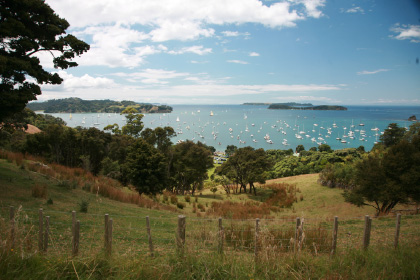Vote yes and no
Auckland governance legislation select committee submissions closed Friday 26 June

Auckland’s Sullivan Bay: As the first natural harbour north of the metropolis, Mahurangi is the favourite place of many Aucklanders—the majority of regatta-goers. Aucklanders, accordingly, are generally happy to help pay for the restoration of the catchment. photographer Max Cumming 2007
By this time next year, there will be a Mahurangi plan.
Mahurangi Action founding chairman John Male made the first bid for a Mahurangi plan in 1975, pitched at the old Rodney County Council, of which he’d been a one-term-is-quite-enough councillor.
The community’s repeated entreaties went unnoticed until February this year, when Auckland Regional Council provisionally committed to collaboratively develop a Mahurangi plan.
When Mahurangi Action made submissions to the Royal Commission on Auckland Governance, it didn’t presume to suggest what arrangements were needed for the entire metropolis. It confined itself to how famously the harbour had fared with its regional council, argued some form of community council would help realise Mahurangi aspirations, and urged that the options examined ultimately be put to people, in a referendum.
At the hearings, chairman Salmon took the editor to task over the latter suggestion:
Surely the royal commission process provides the necessary mandate?
No, until some attractive well-developed models were developed, most folk would struggle to visualise and articulate their governance preferences. This reluctance to poll the people has subsequently handed the moral high ground to the reactionaries, such as Rodney District Council—witness its latest bid to become a unitary authority.
As part of Auckland’s hinterland, the Mahurangi is heavily used by residents of the metropolis, and Aucklanders pay for that. As regional councillor Christine Rose reminded planters at Sullivan Bay on Sunday, when the district council costed going it alone as a unitary authority, it was found that Rodney residents received three dollars of regional services for every dollar spent. At the current rate of expenditure targeting its elevated sediment accumulation rate, the Mahurangi must be receiving many dollars for every dollar of regional rates paid. This is probably what Mahurangi Action will say to the Auckland governance legislation select committee.
Meantime, rather than put meaningful options for the region to the vote, Aotearoa is about to waste $9 million adding to its litany of unproductive referendums.
One option voters might consider, to vent their frustration while waiting for the Citizens Initiated Referenda Act to be fixed:
Vote Yes and No.
